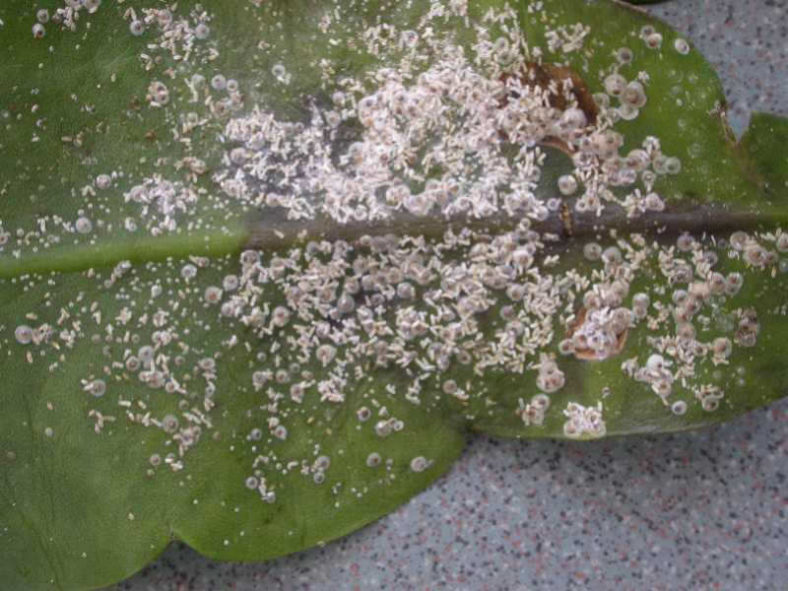Cacti and succulents are relatively pest-free plants, but like many others, they occasionally fall prey to common greenhouse pests like mealybugs, scales, mites, and whiteflies. Do not worry. Plants and pests go hand in hand. You will constantly be bringing pests home with new plants. No matter what you do, you will never be completely free of them. The goal is to control them. Thankfully, there are some simple, relatively toxin-free ways to help deal with the little nasties.
Mealybugs
Mealybugs are the most common pests of cacti and succulents. There are several kinds of mealybugs, but the greenhouse, citrus, and occasionally long-tailed versions are the ones you will encounter most often. They look like tiny, white sowbugs and have the annoying habit of finding the most out-of-the-way spots on your plants. White cottony masses indicate they are reproducing. These are the "nests" that their little crawlers (nearly invisible) call home.
These buggers sap the strength of an infested plant and can cause a visible (though not usually fatal) decline over time, with numbers exploding.
Thankfully, they are among the easiest pests to control. First, lug your plant to the nearest sink or hose and give it a strong shower. Mealybugs can be blasted off their hosts with a forceful stream of water. Another painless way to clean a plant is with a cotton swab dipped in rubbing alcohol (isopropyl). Wipe off any visible debris and rinse the plant with clear water before returning it to its spot. A couple of drops of dishwashing liquid in a quart of water is another weapon in the arsenal. The soap acts as a wetter, breaking down the waxy outer coating of many soft-bodied insects, including mealybugs. Biological controls such as predatory ladybugs and lacewings are also adequate, but may take some time to take effect.
See signs of decline in your succulents for no apparent reason? Remove them from their pots and check the roots. Mealybugs make their home underground and feed on plant roots. They are the worst, often unnoticed until the plant has suffered. Then, off to the sink it went, and it was thoroughly sprayed until no insects or evidence of them remained.
Mites
You do not usually notice mites until they have disfigured your plant. They are attracted to warm, dry conditions, the same environment favored by cacti and succulents. As a result, they are more difficult to control than some other pests. Stressed plants are particularly susceptible.
Mites are not really insects, but they are sucking monsters. It is common to find fine webbing on other plants, but not always on cacti and succulents. More commonly, you will notice brown, corky patches beginning to show up on formerly healthy plants.
Start your control by closely monitoring your plants and scouting for trouble. Keep them healthy and properly watered. Step two: increase the humidity slightly and mist the plants occasionally (most will experience fog in their native habitats; it will not harm them). If you suspect a spider mite infestation, use the "spray them off" technique discussed under mealybug.
It only seems fair that another of their ilk, a predatory mite, is one of the biological controls. It is a perverse little twist of Mother Nature's.
Scales
After mealybugs, the scale insects are probably the most commonly encountered pests of cacti and succulents. These insects are like little armored tanks that clamp themselves to a leaf's surface and inflict damage while hidden beneath a relatively impervious shell.

Not as easy to spray off. Use the rubbing alcohol treatment to remove the scales by hand. A cotton swab or a small, stiff paintbrush will do the trick. They are very difficult to handle, and it is always best to spot an infestation early. Predator insects are available, but they are most effective if you can identify the scale species you are dealing with.
Whitefly
Whiteflies round out the list of important pests to be on guard against. As their name implies, they are small whiteflies. While not common on most succulents, they seem to have a taste for Euphorbias, particularly those with soft leaves.
Parasitic wasps are the most enjoyable way to control these pests. Insecticidal soap sprays can be effective. People have been known to shake their plants and vacuum the insects out of the air. As a short-term help to remove adults, it may have some benefits.
Source: botanicalgardening.com
Photo via missouribotanicalgarden.org
Links
- Succupedia: Browse succulents by Scientific Name, Common Name, Genus, Family, USDA Hardiness Zone, Origin, or cacti by Genus